SKD_BW
Marine/Ocean
- Apr 10, 2019
- 17
Hi all, this has been bugging me for a while so I wanted to see if anyone could give any clarity on it?
My query is in relation to UK Building regulations Part A - Section 6.7.3 Openings and recesses. The regs states "no opening in any case should exceed 3m" - W1, W2 or W3 < 3m - as shown in extract below:

My question is, how can biofolding doors or entrances into extensions above 3m ever be allowable under the building regulations? A quick google search shows bifolds are manufactured up to widths of 8.4m - hence this rule does not seem to be enforced.
One obvious statement would be to use a portal frame (i.e. wind posts / goal posts) however it states "under no circumstance" hence, a portal frame would still not be compliant.
Over the years I have worked on multiple projects which have openings bigger than 3m and this has never been questioned by the buildings inspector - is this simply ignorance, or is there a reason this rule can be exceeded? I have read this section of the building regulations probably monthly for the past 5yrs and this statement has never sat right with me. Is there something I am missing?
Thanks in advance!
My query is in relation to UK Building regulations Part A - Section 6.7.3 Openings and recesses. The regs states "no opening in any case should exceed 3m" - W1, W2 or W3 < 3m - as shown in extract below:

My question is, how can biofolding doors or entrances into extensions above 3m ever be allowable under the building regulations? A quick google search shows bifolds are manufactured up to widths of 8.4m - hence this rule does not seem to be enforced.
One obvious statement would be to use a portal frame (i.e. wind posts / goal posts) however it states "under no circumstance" hence, a portal frame would still not be compliant.
Over the years I have worked on multiple projects which have openings bigger than 3m and this has never been questioned by the buildings inspector - is this simply ignorance, or is there a reason this rule can be exceeded? I have read this section of the building regulations probably monthly for the past 5yrs and this statement has never sat right with me. Is there something I am missing?
Thanks in advance!
